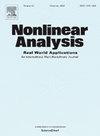二维双曲-抛物型趋化性模型的真空稳态解
IF 1.8
3区 数学
Q1 MATHEMATICS, APPLIED
引用次数: 0
摘要
在本研究中,我们研究了描述血管发生的二维非线性压力双曲-抛物型趋化模型的真空稳态解的存在性。我们在整个空间中寻求径向对称解,在这个解中,系统将被简化为一个在[0,∞)上的ODE系统。ODE系统的基本解决方案是不同类型的贝塞尔函数。我们找到了两个非平凡解。一个是由从r=0开始的半凸起(正密度区域)和右边的真空区域组成。另一个是远离r=0的完全非对称凸起。这些解决方案与体外血管网络和Gamba等人(2003)的数值生成的结构具有一定的相似性。我们还证明了从r=0开始的完全对称凸不存在以及远离r=0的完全对称凸不存在。本文章由计算机程序翻译,如有差异,请以英文原文为准。
Stationary solutions with vacuum for a hyperbolic–parabolic chemotaxis model in dimension two
In this research, we study the existence of stationary solutions with vacuum to a hyperbolic–parabolic chemotaxis model with nonlinear pressure in dimension two that describes vasculogenesis. We seek radially symmetric solutions in the whole space, in which the system will be reduced to a system of ODE’s on . The fundamental solutions to the ODE system are the Bessel functions of different types. We find two nontrivial solutions. One is formed by half bump (positive density region) starting at and a region of vacuum on the right. Another one is a full nonsymmetric bump away from . These solutions bear certain resemblance to in vitro vascular network and the numerically produced structure by Gamba et al. (2003). We also show the nonexistence of full bump starting at and nonexistence of full symmetric bump away from .
求助全文
通过发布文献求助,成功后即可免费获取论文全文。
去求助
来源期刊
CiteScore
3.80
自引率
5.00%
发文量
176
审稿时长
59 days
期刊介绍:
Nonlinear Analysis: Real World Applications welcomes all research articles of the highest quality with special emphasis on applying techniques of nonlinear analysis to model and to treat nonlinear phenomena with which nature confronts us. Coverage of applications includes any branch of science and technology such as solid and fluid mechanics, material science, mathematical biology and chemistry, control theory, and inverse problems.
The aim of Nonlinear Analysis: Real World Applications is to publish articles which are predominantly devoted to employing methods and techniques from analysis, including partial differential equations, functional analysis, dynamical systems and evolution equations, calculus of variations, and bifurcations theory.

 求助内容:
求助内容: 应助结果提醒方式:
应助结果提醒方式:


